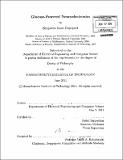Glucose-powered neuroelectronics
Author(s)
Rapoport, Benjamin Isaac
DownloadFull printable version (18.88Mb)
Other Contributors
Massachusetts Institute of Technology. Dept. of Electrical Engineering and Computer Science.
Advisor
Rahul Sarpeshkar.
Terms of use
Metadata
Show full item recordAbstract
A holy grail of bioelectronics is to engineer biologically implantable systems that can be embedded without disturbing their local environments, while harvesting from their surroundings all of the power they require. As implantable electronic devices become increasingly prevalent in scientific research and in the diagnosis, management, and treatment of human disease, there is correspondingly increasing demand for devices with unlimited functional lifetimes that integrate seamlessly with their hosts in these two ways. This thesis presents significant progress toward establishing the feasibility of one such system: A brain-machine interface powered by a bioimplantable fuel cell that harvests energy from extracellular glucose in the cerebrospinal fluid surrounding the brain. The first part of this thesis describes a set of biomimetic algorithms and low-power circuit architectures for decoding electrical signals from ensembles of neurons in the brain. The decoders are intended for use in the context of neural rehabilitation, to provide paralyzed or otherwise disabled patients with instantaneous, natural, thought-based control of robotic prosthetic limbs and other external devices. This thesis presents a detailed discussion of the decoding algorithms, descriptions of the low-power analog and digital circuit architectures used to implement the decoders, and results validating their performance when applied to decode real neural data. A major constraint on brain-implanted electronic devices is the requirement that they consume and dissipate very little power, so as not to damage surrounding brain tissue. The systems described here address that constraint, computing in the style of biological neural networks, and using arithmetic-free, purely logical primitives to establish universal computing architectures for neural decoding. The second part of this thesis describes the development of an implantable fuel cell powered by extracellular glucose at concentrations such as those found in the cerebrospinal fluid surrounding the brain. The theoretical foundations, details of design and fabrication, mechanical and electrochemical characterization, as well as in vitro performance data for the fuel cell are presented.
Description
Thesis (Ph. D.)--Massachusetts Institute of Technology, Dept. of Electrical Engineering and Computer Science, 2011. Cataloged from PDF version of thesis. Includes bibliographical references (p. 157-164).
Date issued
2011Department
Massachusetts Institute of Technology. Department of Electrical Engineering and Computer SciencePublisher
Massachusetts Institute of Technology
Keywords
Electrical Engineering and Computer Science.